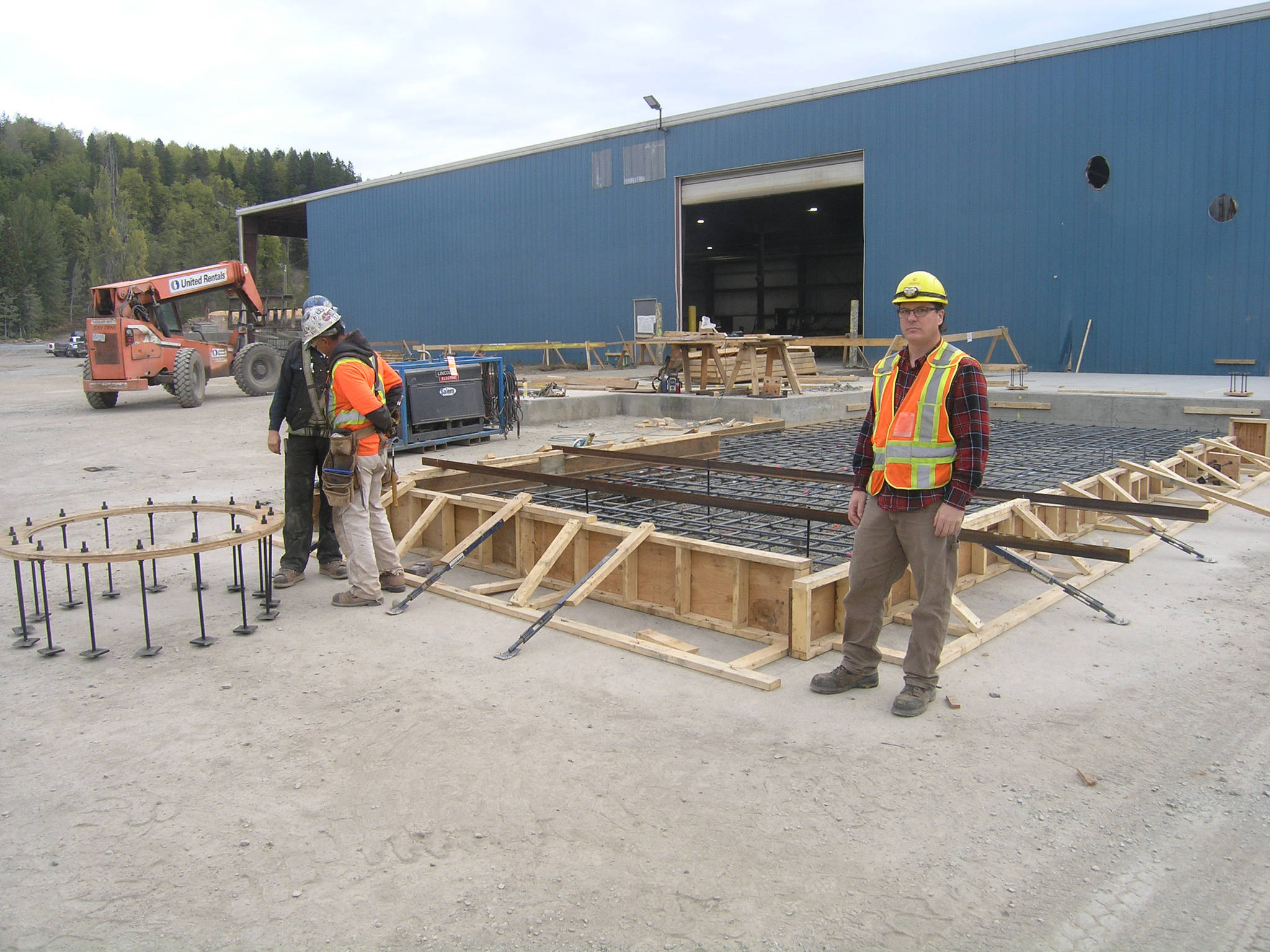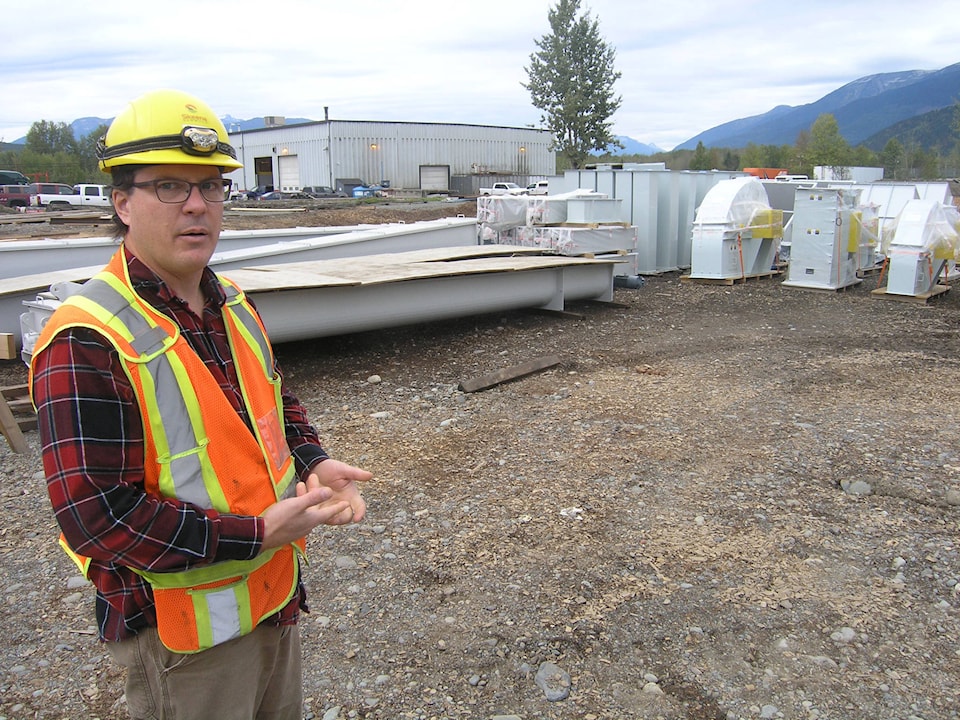After years of failed attempts by other companies to add value beyond producing lumber from the area’s forests, Skeena Sawmills is the first to actually do just that by building a $20 million pellet plant at its mill location on Hwy16 just west of Terrace.
Scheduled to fully open by the middle of next year, the plant belongs to a Skeena Sawmills subsidiary called Skeena Bioenergy and will use shavings and other waste from the mill that’s now being sold to other pellet producers, sold to the Harmac pulp mill on Vancouver Island or land-filled.
“The fact is we’ve simply run out of room [to store waste],” says Nathan Bond, the Skeena Sawmills/Skeena Bioenergy official who’s working closely on the project. “Without this, we’d be stuck.”
Equipment will be installed inside a 20,000 square foot building that was used for previous value-added projects.
Since early summer crews have been preparing footings and foundations outside of the building to hold the raw material and for two silos from which the finished product will be deposited via telescopic chutes into waiting trucks or containers underneath for transport to Prince Rupert for export.
The chutes will retract upward as pellets fill the trucks or containers and are just one example of the safety engineering that’s going into the project, says Bond.
“This way we can control the amount of dust as the pellets come out of the chute. As you know, dust can be a hazard for fires and we want to minimize that as much as possible. That’s our Number One safety concern, to reduce dust.”
The production design is being handled by the Spanish company Prodesa with equipment coming from other European countries such as Germany.
“Europe is so far ahead,” noted Bond as countries there accelerate moves to abandon burning coal to generate electricity and energy. “They’re really looking to green energy sources.”
Bond said some of the 65 shipping containers full of equipment from Europe have already arrived as the project moves closer from preparation and civil works to assembly.
If the project is a first for this area, it’s also a first for Prodesa in B.C., acting as a showcase for that company.
Bond said this plant will be one of the few in B.C. to use a drying system that operates at a lower temperature than other plants.
“The lower the temperature, the less chance of [material] combustion. And that’s an important safety factor,” he said.
The drying system of forced hot air will be fueled by natural gas, something that drew queries from interested parties who wondered why hog fuel waste from the sawmill won’t be used, Bond added.
“The fact is with natural gas we can control it just with a switch,” he said, adding it to the number of designed safety factors. “With hog fuel it takes time to get to the right temperature and then to cool down if needed.”
Raw material will be mixed together and run through a hammer mill to break it up into tiny particles and then placed on a series of conveyors for drying.
Air is forced downward and the conveyor belts also act as filters to capture dust before its exhausted through stacks into the atmosphere.
A second hammer mill further breaks the now-dry material down even further and is blown into a storage bin. The air used to move the product is then sent through a cyclone-like filter system to trap additional particulate material that’s much the same as the bags used in woodworking shops but on a much larger scale before being exhausted.
Rollers then force the material through a ring die, compressing it to form the pellets.
Dust collection and control is not only a safety measure but part of the design to minimize particulate emissions, Bond said.
And having the production machinery inside a building also minimizes the amount of noise that will be heard outside the facility, he added.
Passersby will notice three stacks reaching up and out of the building for emissions which Bond describes as being mostly steamy white fog produced through drying of the material.
“We’re using the best available technology,” he said of particulate emission control.
At full capacity, the plant will produce approximately 75,000 tonnes of pellets a year, requiring that amount in dry fiber or twice that in wet material, says Skeena Sawmills sales and market vice president Rick Harris.
That production amount could increase contingent on the volume of dry fiber the plant can acquire.
“No off-take [sales] agreements have been signed yet, however, we have a number of very strong offers that weare currently reviewing. Should have initial contracts in place by the end of November,” said Harris.
As well as exports, there’s also the possibility of selling pellets to local pellet stove and other users, he added.
“It’s important to us that the community has access to what we produce and we expect to do this through agreements with local suppliers,” Harris said.
Bond added that at current estimates, the local market consumes approximately 500 tonnes of pellets a year.
When in full initial production the plant will employ 12 people on two regular shifts, a number that will increase to 17 if the plant moves to a 24/7 operation.
Terrace mayor Carol Leclerc said she was excited at the construction.
“As we celebrate National Forestry Week in Terrace we can look forward to new jobs and a stronger, sustainable mill that can maximize use of this valuable resource. Projects like this strengthen our community – we congratulate Skeena Sawmills on their hard work and wish them every success,” she said.
Rick Brouwer, the executive director of the non-profit Skeena-Nass Centre for Innovation in Resource Economics think tank, also welcomed the construction.
“Many groups have come to the region to “kick the tires” — not surprising that the one that is getting going is tied to existing milling,” he said.
“It just shows how everything in this region is connected, and that ( in my opinion) future successes will also have to take into account that inter- connectivity,” Brouwer said.

